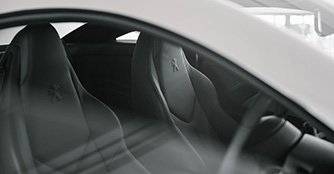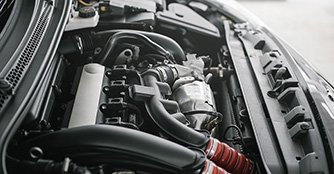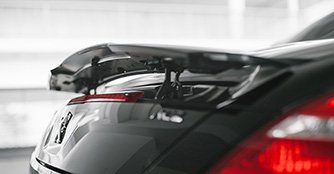Peugeot RCZ 1.6 Turbo (A) Facelift Review
06 Jan 2014|22,187 views
The RCZ first made its presence as the Peugeot 308 RCZ Concept back in 2007. The car became a reality in 2009 when it was introduced at the Frankfurt Auto Show as the RCZ - symbolising a distinctive and singular positioning in relation to the Peugeot range, since it is the first passenger vehicle not to use the numbering system with a 'central zero' or 'double zero'.
And now, following Peugeot's new design direction, the brand is increasing the appeal and exclusivity of the RCZ with a facelift, reaffirming its strong and unmistakable identity.
Up close and Personal
The major changes to the RCZ concern the front fascia. The sporty coupe receives a redesigned front bumper with a wide lower intake that extends to the edges of the car and now includes LED daytime running lights in place of the fog lamps.
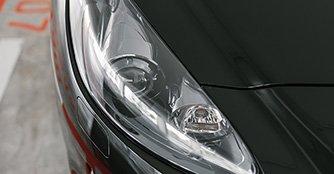
The grille, while retaining the distinctive Peugeot wide-mouth look, has been toned down a little, following the look taken on by Peugeot's most recent 208 supermini, and is being adopted by the rest in the family.
While the RCZ looks great from any angle, it really stands out from the crowd when seen from the side and from the rear. The roof slopes back to the rump almost from the time it leaves the top of the windscreen, giving it a shape like no other car on the road, especially with the distinctive 'double bubble' roof.
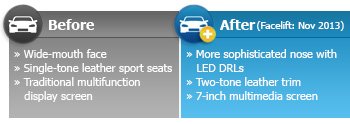 |
The interior of the RCZ is largely the same as the one before and is starting to look dated. Unfortunately, that also means that the cabin still suffers from some ergonomic issues.
The centre console is raked too far forward that the controls become a little hard to be comfortably operated from the driver's seat, coupled with the fact that there are still no controls on the steering wheel. Stretching for the seat belt doesn't help either.
Moving behind, or rather looking behind, the back seat in the RCZ is one that can either be used by children or very tolerant adults, but only for short distances. Nonetheless, the boot capacity of the RCZ, at 384 litres, is more spacious than you think.
It's not a bad interior after all, but Peugeot could have updated it along with the car's nose. In this case, the only changes would be the addition of a two-tone leather trim and a 7-inch pop up infotainment screen, though our test car was specced without both.
 |
The Drive
Nip and tuck on the outside, but the Pug's heart remains unchanged in this operation. Producing 156bhp and 240Nm of torque is a 1.6-litre turbocharged powerplant. The engine feels smooth and refined with a wide torque band that makes the car flexible and easy to drive around town.
While there is also a manual override function available with the six-speed Tiptronic transmission, it doesn't come with paddle shifters that we've come to expect in cars of this type. Nonetheless, gear shifts are smooth when left to its own devices. Along with the punchy engine, the Pug reaches the century mark from standstill in nine seconds.
Handling is neat with a weighty and sharp steering, though it lacks the communication with the driver. However, the trade-off is minimal body roll in corners and loads of reassuring grip.
Given the firm suspension setup, the ride can be a little harsh at times but it is still quiet and relaxing enough for longer trips.
Conclusion
Coupes are all about style and that's one thing the RCZ has in abundance. With an enhanced look now, the sporty coupe from Peugeot will never fail to turn heads no matter where it goes.
The RCZ first made its presence as the Peugeot 308 RCZ Concept back in 2007. The car became a reality in 2009 when it was introduced at the Frankfurt Auto Show as the RCZ - symbolising a distinctive and singular positioning in relation to the Peugeot range, since it is the first passenger vehicle not to use the numbering system with a 'central zero' or 'double zero'.
And now, following Peugeot's new design direction, the brand is increasing the appeal and exclusivity of the RCZ with a facelift, reaffirming its strong and unmistakable identity.
Up close and Personal
The major changes to the RCZ concern the front fascia. The sporty coupe receives a redesigned front bumper with a wide lower intake that extends to the edges of the car and now includes LED daytime running lights in place of the fog lamps.
The grille, while retaining the distinctive Peugeot wide-mouth look, has been toned down a little, following the look taken on by Peugeot's most recent 208 supermini, and is being adopted by the rest in the family.
While the RCZ looks great from any angle, it really stands out from the crowd when seen from the side and from the rear. The roof slopes back to the rump almost from the time it leaves the top of the windscreen, giving it a shape like no other car on the road, especially with the distinctive 'double bubble' roof.
The interior of the RCZ is largely the same as the one before and is starting to look dated. Unfortunately, that also means that the cabin still suffers from some ergonomic issues.
The centre console is raked too far forward that the controls become a little hard to be comfortably operated from the driver's seat, coupled with the fact that there are still no controls on the steering wheel. Stretching for the seat belt doesn't help either.
Moving behind, or rather looking behind, the back seat in the RCZ is one that can either be used by children or very tolerant adults, but only for short distances. Nonetheless, the boot capacity of the RCZ, at 384 litres, is more spacious than you think.
It's not a bad interior after all, but Peugeot could have updated it along with the car's nose. In this case, the only changes would be the addition of a two-tone leather trim and a 7-inch pop up infotainment screen, though our test car was specced without both.
The Drive
Nip and tuck on the outside, but the Pug's heart remains unchanged in this operation. Producing 156bhp and 240Nm of torque is a 1.6-litre turbocharged powerplant. The engine feels smooth and refined with a wide torque band that makes the car flexible and easy to drive around town.
While there is also a manual override function available with the six-speed Tiptronic transmission, it doesn't come with paddle shifters that we've come to expect in cars of this type. Nonetheless, gear shifts are smooth when left to its own devices. Along with the punchy engine, the Pug reaches the century mark from standstill in nine seconds.
Handling is neat with a weighty and sharp steering, though it lacks the communication with the driver. However, the trade-off is minimal body roll in corners and loads of reassuring grip.
Nip and tuck on the outside, but the Pug's heart remains unchanged in this operation. Producing 156bhp and 240Nm of torque is a 1.6-litre turbocharged powerplant. The engine feels smooth and refined with a wide torque band that makes the car flexible and easy to drive around town.
While there is also a manual override function available with the six-speed Tiptronic transmission, it doesn't come with paddle shifters that we've come to expect in cars of this type. Nonetheless, gear shifts are smooth when left to its own devices. Along with the punchy engine, the Pug reaches the century mark from standstill in nine seconds.
Handling is neat with a weighty and sharp steering, though it lacks the communication with the driver. However, the trade-off is minimal body roll in corners and loads of reassuring grip.
Given the firm suspension setup, the ride can be a little harsh at times but it is still quiet and relaxing enough for longer trips.
Conclusion
Coupes are all about style and that's one thing the RCZ has in abundance. With an enhanced look now, the sporty coupe from Peugeot will never fail to turn heads no matter where it goes.
Also read our comparison article on:
Peugeot RCZ 1.6 Turbo (A) vs MINI Cooper S Coupe 1.6 (A)Car Information
Peugeot RCZ 1.6 Turbo (A)
CAT B|Petrol|13.6km/L
Horsepower
116kW (156 bhp)
Torque
240 Nm
Acceleration
9sec (0-100km /hr)
This model is no longer being sold by local distributor
All Used Peugeot RCZThank You For Your Subscription.



























